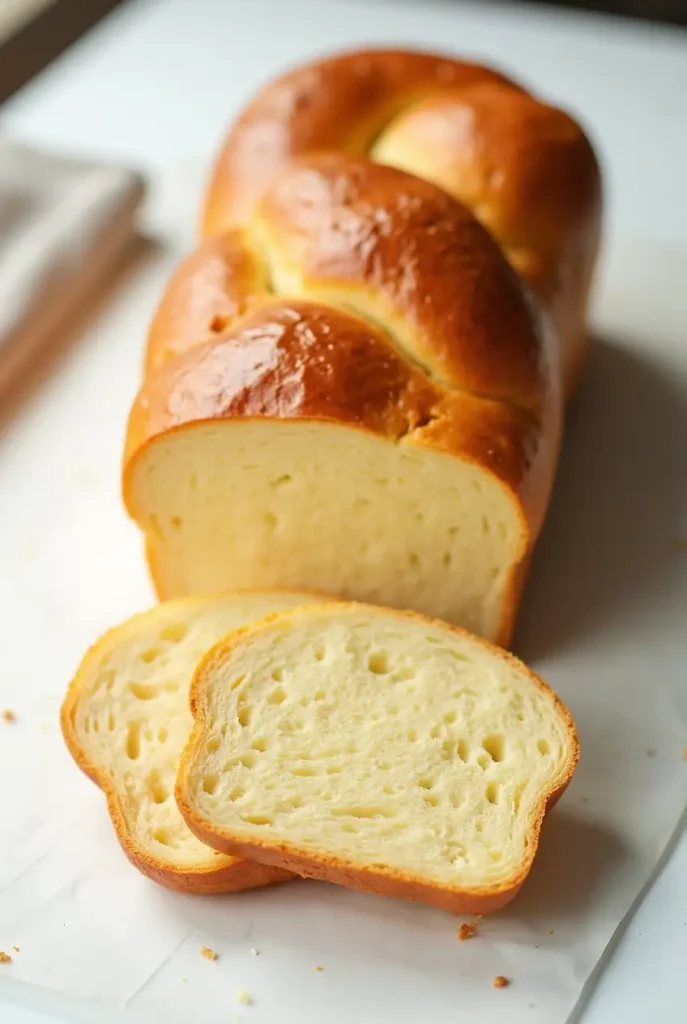Homemade brioche bread is a treat like no other. With its rich, buttery flavor and soft, fluffy texture, it’s perfect for everything from French toast to sandwiches. While it takes a little time, the result is a light, delicious loaf that’s totally worth the effort. This simple brioche bread recipe will guide you step by step to create a loaf that’s sure to impress!
Key Benefits of Brioche Bread
Making your own brioche bread is not just about creating a delicious loaf—it’s about enjoying the process and the results. Here are some of the key benefits that make this bread so special:
- Rich, Buttery Flavor: Brioche is made with butter, eggs, and milk, giving it a luxurious taste that other breads just can’t match. This rich texture is perfect for both sweet and savory dishes.
- Soft and Fluffy: The combination of ingredients and proper rising time results in a loaf that’s incredibly light and airy. It’s the kind of bread that melts in your mouth with every bite.
- Versatility: Brioche isn’t just for special occasions. It’s perfect for breakfast as French toast, or enjoy it with a layer of jam or honey. It also makes a fantastic base for sandwiches or even bread pudding.
- Satisfying to Make: While it may take a little time and patience, there’s something incredibly rewarding about watching this dough rise and transform into a beautiful, golden loaf.
- Perfect for Baking Beginners and Experts: Whether you’re a seasoned baker or new to the world of bread-making, this yeast-based dough is approachable and easy to master.

Ingredients for brioche bread recipe
All-purpose flour: Use all-purpose flour for the right texture or bread flour for a chewier result.
Sugar: Sugar sweetens and helps the yeast rise, so don’t substitute it.
Active dry yeast: Yeast makes the bread light and fluffy. Ensure it’s fresh.
Salt: Salt enhances flavor and balances the richness.
Eggs: Eggs give structure, richness, and color. Use room-temperature eggs.
Unsalted butter: Butter adds moisture and flavor. You can use salted butter, but reduce the salt.
Whole milk: Whole milk adds moisture and helps with texture. Warm it for the yeast.
Vanilla extract (optional): This adds flavor, but it’s optional for a traditional brioche.
Instructions for Brioche Bread
Making brioche bread may take a bit of time, but the process is simple and incredibly rewarding. Follow these steps to create your perfect loaf:
Activate the yeast: Warm milk, dissolve sugar, add yeast, and let sit for 5-10 minutes until frothy.
Combine dry ingredients: Whisk flour and salt together.
Add wet ingredients: Mix the frothy yeast mixture with the eggs and vanilla, forming a sticky dough.
Knead the dough: Knead for 10 minutes on a floured surface until smooth and elastic, or 5-6 minutes with a stand mixer.
Incorporate the butter: Slowly add softened butter and knead until fully incorporated and the dough is smooth.
First rise: Let the dough rise in a greased bowl for 1.5-2 hours until doubled in size.
Shape the dough: Punch down the dough and shape it into a loaf, then place it in a greased loaf pan.
Second rise: Let the shaped dough rise for 45 minutes until doubled in size.
Bake the bread: Preheat oven to 350°F (175°C), brush with egg wash, and bake for 25-30 minutes until golden brown.
Cool and enjoy: Let cool in the pan for 10 minutes, then transfer to a wire rack to cool completely before slicing.
Pro Tips for Perfect Brioche Bread
Making brioche bread can be a bit of a process, but these pro tips will help ensure your loaf turns out perfectly every time:
Use room-temperature ingredients: For the best texture, make sure your butter and eggs are at room temperature. This allows them to blend smoothly into the dough, creating that soft, airy texture brioche is known for.
Don’t rush the rises: The two rises are crucial for getting that light, fluffy loaf. If you’re in a hurry, it’s tempting to rush through this step, but giving the dough time to rise fully will result in a much better texture.
Knead thoroughly: Kneading is essential for developing gluten and getting the right consistency in your dough. If you’re kneading by hand, give it a full 10 minutes of attention. The dough should be smooth and elastic, not sticky. If you’re using a stand mixer, 5–6 minutes on low speed should be enough.
Add butter gradually: When you’re incorporating the butter into the dough, do it slowly, adding small pieces at a time. This helps the butter fully absorb into the dough, giving it that delicious richness and softness.
Watch your oven temperature: Make sure your oven is fully preheated before baking. If your oven runs hot, consider lowering the temperature by 10-15°F (5-10°C) to prevent the bread from browning too quickly on the outside before it cooks through.
Egg wash for a golden finish: Brushing the top of your dough with an egg wash (1 egg beaten with a tablespoon of water) before baking will give your brioche a beautiful, golden sheen that’s perfect for presentation.
Let it cool properly: Once your brioche bread is baked, let it cool in the pan for about 10 minutes. This helps the bread firm up a bit, making it easier to slice without squishing the soft interior.
Variations of Brioche Bread
Once you’ve mastered the classic brioche bread, there are so many fun ways to customize it and make it your own. Here are a few variations to try:
Cinnamon Swirl Brioche: For a delicious twist, add cinnamon sugar to the dough before rolling it up in the pan. Once baked, you’ll have a sweet, aromatic swirl throughout the bread that’s perfect for breakfast or dessert.
Chocolate Brioche: Fold some chocolate chips or chunks into your dough for a rich, indulgent variation. This makes for an irresistible treat when served with coffee or as a snack.
Orange Zest Brioche: Add some freshly grated orange zest to the dough for a citrusy fragrance and flavor that pairs wonderfully with the buttery richness of the bread. It’s a refreshing twist, especially for the warmer months.
Serving Suggestions for Brioche Bread
Classic Breakfast: Slice a piece of brioche bread and toast it lightly. Spread a bit of butter and drizzle with honey or jam for a simple, indulgent breakfast. You can also top it with fresh berries or sliced bananas for added sweetness and texture.
With Coffee or Tea: For a light snack or an afternoon treat, pair a slice of brioche bread with your favorite cup of coffee or tea. The soft texture and rich flavor of the bread complement both hot and cold beverages perfectly.
More Bread recipes you will love!
bread pudding recipe old fashion
FAQs About brioche bread recipe
What makes brioche different from most breads?
Brioche bread stands out due to its rich, buttery flavor and soft, pillowy texture. Unlike traditional breads, brioche contains more butter, eggs, and milk, giving it a sweeter, richer taste. It’s often considered more of a pastry than regular bread, which is why it has such a tender crumb and slightly sweet flavor.
What is brioche bread best used for?
Brioche bread is incredibly versatile! It’s perfect for a luxurious breakfast when toasted with butter and jam. You can also use it for making French toast, bread pudding, or even sandwiches. Its slightly sweet flavor makes it an ideal base for both sweet and savory dishes.
What is the best flour to use for brioche?
For the best texture, use bread flour in your brioche bread recipe. Bread flour has a higher protein content, which helps the dough develop the gluten needed to achieve that soft, airy texture. You can substitute with all-purpose flour, but bread flour yields the best results for an authentic brioche loaf.
Is brioche bread healthy?
Brioche bread is rich in butter, eggs, and sugar, making it a more indulgent bread compared to others. While it’s not the healthiest option in terms of calorie count, it can be enjoyed in moderation as a delicious treat or special occasion bread. If you’re looking for a lighter alternative, consider making a modified version with less butter or using healthier fats like olive oil.
Why is my brioche not fluffy?
If your brioche bread isn’t turning out fluffy, there are a few things to check. Ensure you’re giving the dough enough time to rise, as underproofed dough can lead to denser bread. Also, make sure you’re using fresh yeast and kneading the dough thoroughly to develop the right texture. Finally, be mindful of the oven temperature—too high of a heat can cause the bread to rise too quickly, leaving it dense inside.

brioche bread recipe
Ingredients
- 3 ½ cups all-purpose flour
- ¼ cup sugar
- 2 ¼ teaspoons active dry yeast
- 1 teaspoon salt
- 4 large eggs room temperature
- 1 cup unsalted butter softened
- ½ cup whole milk warm
- 1 teaspoon vanilla extract optional
Instructions
Activate the yeast:
- In a small bowl, warm the milk (about 110°F or 43°C) and dissolve the sugar into it. Sprinkle the active dry yeast over the milk and let it sit for 5–10 minutes until the mixture becomes frothy. This means your yeast is ready to work its magic!
Combine dry ingredients:
- In a large mixing bowl, whisk together the flour and salt. This ensures the salt is evenly distributed and helps in building the bread’s structure.
Add wet ingredients:
- Once your yeast mixture is frothy, pour it into the flour mixture. Add the eggs and vanilla extract (if using). Mix everything together until it forms a sticky dough.
Knead the dough:
- Turn the dough out onto a lightly floured surface. Knead for about 10 minutes until it becomes smooth and elastic. If you have a stand mixer, you can use the dough hook attachment and knead on low speed for about 5–6 minutes. The dough should feel soft but not overly sticky.
Incorporate the butter:
- Slowly add the softened butter, a little bit at a time, into the dough. Continue kneading until the butter is fully incorporated and the dough is shiny and smooth. This step is crucial for achieving that rich, buttery texture.
First rise:
- Place the dough in a lightly greased bowl, cover it with a clean kitchen towel, and let it rise in a warm place for about 1 ½ to 2 hours, or until it has doubled in size. This is when the yeast does its work, creating a light and fluffy texture.
Shape the dough:
- After the dough has risen, punch it down gently to release the air. Shape the dough into a loaf by folding the edges inward and rolling it tightly. Place it in a greased loaf pan.
Second rise:
- Cover the shaped dough with a towel and let it rise again for about 45 minutes, or until it has doubled in size. This second rise gives your brioche bread its final fluffiness.
Bake the bread:
- Preheat your oven to 350°F (175°C). Once the dough has finished its second rise, brush the top with a little egg wash (1 beaten egg with 1 tablespoon water) for a golden finish. Bake the bread for 25-30 minutes, or until the top is golden brown and a toothpick inserted comes out clean.
Cool and enjoy:
- Let the brioche cool in the pan for about 10 minutes before transferring it to a wire rack to cool completely. Slice and enjoy this rich, soft loaf fresh out of the oven!
Send me this recipe!
Just enter your email below and get it sent straight to your inbox!


